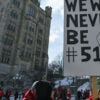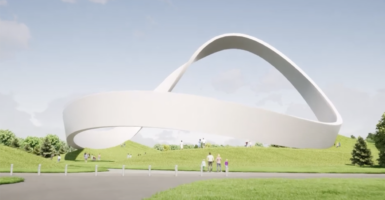ORLANDO, Fla.—A giant infinity loop, constructed using 1 million white bricks, will serve as a monument to answered prayer in the United Kingdom.
“Every single brick represents a story of answered prayer,” Richard Gamble, founder of the Eternal Wall of Answered Prayer, told The Daily Signal in an interview last month at the National Religious Broadcasters Convention in Orlando, Florida. “People will be able to come. They’ll be able to point their phones at any one of the bricks on this structure, and their phone will light up, and it will tell them a story of hope—a story of when somebody’s prayed to Jesus, and how He’s answered.”
“Our hope is that we are going to build a globally known landmark, so that, all over the world, people will be Googling it and finding these million stories of answered prayer,” Gamble said. “And it’s a way for us to make hope visible.”
The Eternal Wall of Answered Prayer will stand at 169 feet tall in Coleshill, Birmingham, 90 miles north of London. According to the project’s website, the colossal piece of architecture will be visible from nearly six miles away. The project estimates that 500,000 people will travel past the monument each week, and 200,000 will visit the site annually.
Gamble said he has a team focused on “gathering all the prayers from as early as we can go.” He said they recovered one “from 500 A.D. in Scotland, where somebody prayed for a young boy to be raised from the dead, and he came back to life.” He mentioned stories of martyrs praying for peace as they died, and witnesses recording that they looked peaceful.
He admitted that “a lot of stories of answered prayers are subjective,” but his team has “built in some fail-safes to make sure that nobody’s abusing the system.”
“Some of the answered prayers are undeniable,” Gamble noted. “We’ve got one story of somebody who had cancer, and a lot of people were praying for them, and the surgeon was going to cut out the tumor, and the tumor shrunk before his eyes. Now, stuff like that, that’s undeniable. But, of course, some of the answered prayers are around character. ‘God gave me wisdom,’ ‘God helped me love my wife more than ever.’ I think those are equally as important.”
The project has gathered prayers from more than 85 countries and aims to acquire 80,000 more from the U.S. As researchers discover new answered prayers from history, and as people today send in their own submissions, Gamble said he hopes the database will grow well beyond 1 million.
He said he plans for this never to become a “dead monument.”
“It needs to be a living monument that is continually telling people that Jesus is still alive, and he’s working in our modern day, and he answers prayer,” he explained.
The project’s founder said he is not building any technology into the structure, because it will likely become outdated quickly. Instead, he plans to update the project to suit emerging technology.
“We want to use this monument to communicate to the younger generation that Jesus is alive,” Gamble said. “My hope and prayer is that a 13-year-old girl in Peru, she can go, and she can look at these stories in her own home, and she’ll be able to Google, ‘OK, well, has God answered any prayers in Peru?’ And then she’ll be able to see all the Peru stories. Or, ‘Has God answered any prayer for a 13-year-old girl and the issues that she’s challenged with?’ And she’ll be able to see all those stories.”
Gamble has worked with many different Christian denominations to launch the project, and he said his position as a member of an independent church helped the project from becoming too sectarian.
Churches across the United Kingdom have joined his effort, blessing the project. “We’ve got the whole range of churches, because we should be able to unite on this fact: We believe in prayer,” he said.
Gamble told The Daily Signal that he successfully purchased the land and acquired zoning rights, and the project has accumulated 90% of the necessary funds for phase one, which involves road construction, the compound area, and design work. The project has already raised most of the $3.2 million U.S. for that first phase, but the entire project is estimated to cost $12.6 million U.S. Phases two and three—segment construction and erection of the arch—will require significant funding.
He encouraged U.S. listeners to go to eternalwall.us to submit stories or contribute to the project. He also told The Daily Signal how much money he expects the project to bring in, and what sort of charities will receive portions of those funds.
Editor’s Note: The fundraising information originally included in this story has been corrected to more accurately reflect the progress of the Eternal Wall of Answered Prayer.
Listen to the podcast below or read the lightly edited transcript.
Tyler O’Neil: This is Tyler O’Neil, managing editor at The Daily Signal, and I’m joined by Richard Gamble, founder of The Eternal Wall of Answered Prayer. Really excited by this project. Love to hear you say more about it.
Richard Gamble: Yeah, thank you for having me. So, this is a plan to build a national landmark about Jesus in the United Kingdom. The Eternal Wall is a giant infinity loop, which is about the size of a football pitch. It’s white. It arches 167 meters—167 feet, rather—into the skyline. But the thing about it is every single brick represents a story of answered prayer.
People will be able to come, they’ll be able to point their phones at any one of the bricks on this structure, and their phone will light up and it will tell them a story of hope, a story of when somebody’s prayed to Jesus and how he’s answered.
Our hope is that we are going to build a globally known landmark so that all over the world people will be Googling it and finding these million stories of answered prayer. And it’s a way for us to make hope visible.
O’Neil: How big is this database that you’re working with? I mean, are we talking prayers like the prayers of Perpetua to the present or are we talking mostly modern prayers?
Gamble: No. We’ve got a team, a separate team, that are gathering all the prayers from as early as we can go. We uncovered one the other day from 500 A.D. in Scotland where somebody prayed for a young boy to be raised from the dead and he came back to life.
So we’re trying to capture all these stories. We’ve got stories of martyrs praying for peace before the day they were killed and people recording how peaceful they looked the following day.
We are trying to get around 75,000 prayers from history and then we are just asking people to share it with the current generation. But once we get to a million, that’ll be great. But because it’s all digital, we can then put two stories of answered prayer on a brick and go for 2 million.
And the idea is of this never being a dead monument. It needs to be a living monument that is continually telling people that Jesus is still alive and he’s working in our modern day and he answers prayer.
O’Neil: So how does the team corroborate the answers of prayer? I mean, I think this is an amazing idea, but people also want to know that these prayers really were answered.
Gamble: Yeah. And of course that is the great challenge, isn’t it? I mean, a lot of stories of answered prayers are subjective. We had one person who said he prayed for God to give him a singing voice. Well, I’ve watched enough of “American Idol” to know that not everybody who thinks they’ve got a singing voice has actually got one. But for me, then, it’s a piece of art. So we’ve built in some fail-safes to make sure that nobody’s abusing the system and making sure that it’s clean in that respect.
But of course, prayer, as always, there’s elements sometimes. Some of the answered prayers are undeniable. … We’ve got one story of somebody who had cancer and a lot of people were praying for them and the surgeon was going to cut out the tumor and the tumor shrunk before his eyes. Now, stuff like that, that’s undeniable.
But of course, some of the answered prayers are around character: “God gave me wisdom.” “God helped me love my wife more than ever.” I think those are equally as important.
So, we can’t go through all of them. We just want to need to make sure that the system is not abused.
O’Neil: Yeah. Of course. And this is a monument in England. Are you a member of the Church of England or is it affiliated with any specific Christian denomination?
Gamble: Yeah. Well, it’s interesting. So, God told me about this 19 years ago, and I’m part of an independent church and I think that’s been a good move by God, to be honest, because in two weeks’ time we’ve got 130 leaders of U.K. churches all gathering together to pray a blessing on the land. I think if I was in one denomination then people are like, “Oh, we don’t want to get involved because that denomination.” So I think that was part of his strategy, really, involving me.
O’Neil: So that’s in two weeks. Are there any notable names that you would mention that are going to be there?
Gamble: Yeah. I mean, people like [Bishop] Mike Royal, who took part in the coronation, different bishops and deacons, and we’ve got the whole range of churches because we should be able to unite on this fact: We believe in prayer.
But it’s not just a U.K. thing. … Out of these million prayers, we’ve got 100,000 which are for the United States.
So we are trying to get people from the states to give us five minutes of their time, come onto our website, eternalwall.us, and just share a story of answered prayer. Because the exciting thing of this project is the power in the testimony and the fact that people who read this are going to be inspired and they’re going to read this in 10 years’ time, in 50 years’ time, in 100 years’ time. This monument is not going to go away.
O’Neil: Yeah, that’s inspiring. When it comes to choosing to have a digital—I think it’s funny because when you say having a concrete, well, not built out of concrete, but a physical monument and then you use a phone to illuminate it, we like to think the current technology’s always going to be here, but it may not. I mean, I think of Pokemon GO for instance, which used a somewhat similar geolocation thing and it has had a falling off.
… And of course this is a hard question to answer, but how do you anticipate changing with the technology?
Gamble: So, the first thing is we’re not building any technology into the monument because the moment you do, it’s out of date. So the idea is, initially, we’ll start with an app, and obviously technology’s going to keep moving forward. The business model for this pays for itself and then some, so we can all always be making sure that we’ve got some money in the background to take the next technological push.
So who knows what we’ll be doing? Maybe we’ve got Google glasses, who knows, maybe there’ll be implants in 50 years, but we’ll make sure that we’ve got the funding to make sure that we’re keeping in step with technology.
That’s really important because we want to use this monument to communicate to the younger generation that Jesus is alive. So from Monday to Friday, I would imagine this is going to be filled with schools and colleges coming to look.
And my hope and prayer is that a 13-year-old girl in Peru, she can go and she can look at these stories in her own home and she’ll be able to Google, “OK, well, has God answered any prayers in Peru?” And then she’ll be able to see all the Peru stories. Or, “Has God answered any prayer for a 13-year-old girl and the issues that she’s challenged with?” And she’ll be able to see all those stories.
And it’s a real way for us to say to the younger generation, “Hey, God is still in your space and Jesus is still answering.”
O’Neil: I’ve heard that the project is about 90% funded. Are you accepting private donations? You were saying that it would pay for itself. What do you mean by that?
Gamble: Yeah. So, the answer is yes. We are 90% funded. [By this, Gamble meant he had funded 90% of the first of three phases.] And yes, please, we still need more donations.
I think it’s also part important, we are collecting donations from the public and wealthy individuals have put in some chunks to get us where we are. But I think it’s really powerful to tell the world that when we get up and when we open, to be able to say, “Hey, we’ve got 100,00 people [that] have backed this.” That’s a story in itself.
And in terms of how we’re funding going on, the business model, most landmarks, people are visiting all the time. We’ll charge for car park and stuff like that. We developed this so the maintenance costs are low in terms of the structure.
So we believe by year five we reckon we’re going to be making about 700,000 a year. And some of that will be for legacy funding moving forward and the rest of it is going to go into other Christian charities and good works.
O’Neil: So which charities would you be looking to partner with in that case? I mean, naturally, it’s further down the line, but are there any you have in mind?
Gamble: Well, one element is social housing. So we want to fund over a million bricks into social housing around the world. So it’d be really cool that not only we’ve got a million bricks here, but bricks all over the world sort of helping the poor. But then I also want to make sure that we help people who’ve also got crazy God ideas and help them get things off the ground.
This has been 19 years. It’s been a hard journey. And my real hope is that for the young generation, they’ll go, “Gosh, if God can get that bloke and these ragtag bunch of people to build a landmark, he can definitely help me with my dream.” And we hope it’s going to inspire them, too.
O’Neil: Wow. Well, that’s very inspiring. So where can people go again to submit prayers, to see, to help?
Gamble: So if you can help us, you’re going to help us change the world, and your testimony is going to last for a long time. So please give us five minutes. Go to Eternalwall.us and share as many stories as you’ve got of the times that you’ve prayed and Jesus has answered.
O’Neil: Amen. Well, thank you so much, Richard Gamble, for joining us.
Gamble: Thank you. Thank you for having me on.
Have an opinion about this article? To sound off, please email [email protected] and we’ll consider publishing your edited remarks in our regular “We Hear You” feature. Remember to include the url or headline of the article plus your name and town and/or state.






























